Early evidence of Acheulean settlement in northwestern Europe--la Noira site, a 700,000 year-old occupation in the center of France
- PMID: 24278105
- PMCID: PMC3835824
- DOI: 10.1371/journal.pone.0075529
Early evidence of Acheulean settlement in northwestern Europe--la Noira site, a 700,000 year-old occupation in the center of France
Abstract
The human settlement of Europe during Pleistocene times was sporadic and several stages have been recognized, both from paleaoanthropological and archaeological records. If the first phase of hominin occupation (as early as 1.4 Ma) seems mainly restricted to the southern part of the continent, the second phase, characterized by specific lithic tools (handaxes), is linked to Acheulean settlements and to the emergence of Homo heidelbergensis, the ancestor of Neanderthals. This phase reached northwestern Europe and is documented in numerous sites in Germany, Great Britain and northern France, generally after 600 ka. At la Noira (Brinay, Central France), the Middle Pleistocene alluvial formation of the Cher River covers an archaeological level associated with a slope deposit (diamicton). The lithic assemblage from this level includes Large Cutting Tools (LCTs), flakes and cores, associated with numerous millstone slabs. The lithic series is classified as Acheulean on the basis of both technological and typological analyses. Cryoturbation features indicate that the slope deposits and associated archaeological level were strongly frozen and disturbed after hominin occupation and before fluvial deposition. Eight sediment samples were dated by the electron spin resonance (ESR) method and the weighted average age obtained for the fluvial sands overlying the slope deposits is 665±55 ka. This age is older than previous chronological data placing the first European Acheulean assemblages north of 45(th) parallel north at around 500 ka and modifies our current vision of the initial peopling of northern Europe. Acheulean settlements are older than previously assumed and the oldest evidences are not only located in southern Europe. La Noira is the oldest evidence of Acheulean presence in north-western Europe and attests to the possibility of pioneering phases of Acheulean settlement which would have taken place on a Mode 1-type substratum as early as 700 ka. The lithic assemblage from la Noira thus provides behavioral and technological data on early Acheulean occupation in Europe and contributes to our understanding of the diffusion of this tradition.
Conflict of interest statement
Figures

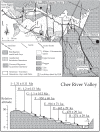
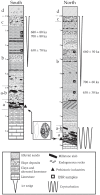
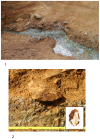

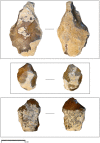
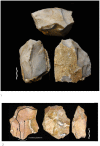
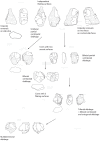

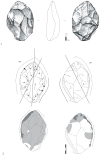
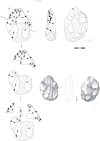
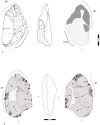
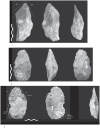
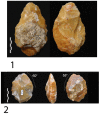
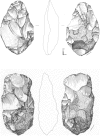

Similar articles
-
Tracking behavioral persistence and innovations during the Middle Pleistocene in Western Europe. Shift in occupations between 700 and 450 ka at la Noira site (Centre, France).J Hum Evol. 2021 Jul;156:103009. doi: 10.1016/j.jhevol.2021.103009. Epub 2021 May 25. J Hum Evol. 2021. PMID: 34049270
-
New geochronological, paleoclimatological, and archaeological data from the Narmada Valley hominin locality, central India.J Hum Evol. 2009 Feb;56(2):114-33. doi: 10.1016/j.jhevol.2008.08.023. Epub 2008 Dec 31. J Hum Evol. 2009. PMID: 19118867
-
Earliest evidence of human occupations and technological complexity above the 45th North parallel in Western Europe. The site of Lunery-Rosieres la-Terre-des-Sablons (France, 1.1 Ma).Sci Rep. 2024 Jul 23;14(1):16894. doi: 10.1038/s41598-024-66980-4. Sci Rep. 2024. PMID: 39043764 Free PMC article.
-
New luminescence ages for the Galería Complex archaeological site: resolving chronological uncertainties on the acheulean record of the Sierra de Atapuerca, northern Spain.PLoS One. 2014 Oct 22;9(10):e110169. doi: 10.1371/journal.pone.0110169. eCollection 2014. PLoS One. 2014. PMID: 25338076 Free PMC article.
-
Variability in an early hominin percussive tradition: the Acheulean versus cultural variation in modern chimpanzee artefacts.Philos Trans R Soc Lond B Biol Sci. 2015 Nov 19;370(1682):20140358. doi: 10.1098/rstb.2014.0358. Philos Trans R Soc Lond B Biol Sci. 2015. PMID: 26483536 Free PMC article. Review.
Cited by
-
When is a handaxe a planned-axe? exploring morphological variability in the Acheulean.PLoS One. 2024 Jul 16;19(7):e0307081. doi: 10.1371/journal.pone.0307081. eCollection 2024. PLoS One. 2024. PMID: 39012913 Free PMC article.
-
Age and date for early arrival of the Acheulian in Europe (Barranc de la Boella, la Canonja, Spain).PLoS One. 2014 Jul 30;9(7):e103634. doi: 10.1371/journal.pone.0103634. eCollection 2014. PLoS One. 2014. PMID: 25076416 Free PMC article.
-
On the earliest Acheulean in Britain: first dates and in-situ artefacts from the MIS 15 site of Fordwich (Kent, UK).R Soc Open Sci. 2022 Jun 22;9(6):211904. doi: 10.1098/rsos.211904. eCollection 2022 Jun. R Soc Open Sci. 2022. PMID: 35754990 Free PMC article.
-
A Human Deciduous Tooth and New 40Ar/39Ar Dating Results from the Middle Pleistocene Archaeological Site of Isernia La Pineta, Southern Italy.PLoS One. 2015 Oct 12;10(10):e0140091. doi: 10.1371/journal.pone.0140091. eCollection 2015. PLoS One. 2015. PMID: 26457581 Free PMC article.
-
New magnetostratigraphic evidence for the age of Acheulean tools at the archaeo-palaeontological site "Solana del Zamborino" (Guadix - Baza Basin, S Spain).Sci Rep. 2017 Oct 18;7(1):13495. doi: 10.1038/s41598-017-14024-5. Sci Rep. 2017. PMID: 29044215 Free PMC article.
References
-
- Carbonell E, Garcia-Anton MD, Mallol C, Mosquera M, Ollé A, et al. (1999) The TD6 lithic industry from Gran Dolina, Atapuerca (Burgos, Spain) production and use. J Hum Evol 37: 653–693. - PubMed
-
- Arzarello M, Marcollini F, Pavia G, Pavia M, Petronio C, et al. (2006) Evidence of earliest human occurrence in Europe: the site of Pirro Nord (Southern Italy). Naturwissenschaften 94: 107–112. - PubMed
-
- Parfitt SA, Barendregt RW, Breda M, Candy I, Collins MJ, et al. (2005) The earliest record of human activity in northern Europe. Nature 438 (15) 1008–1012. - PubMed
-
- Parfitt SA, Ashton N, Lewis SG, Abel RL, Coope GR, et al. (2010) CB (2010) Early Pleistocene human occupation at the edge of the boreal zone in northwest Europe. Nature 466: 229–233. - PubMed
-
- Carrión JS, Rose J, Stringer C (2011) Early Human Evolution in the Western Palaearctic: Ecological Scenarios. Quat Sci Rev 30 ((11–12)) 1281–1295.
Publication types
MeSH terms
LinkOut - more resources
Full Text Sources
Other Literature Sources
Miscellaneous

